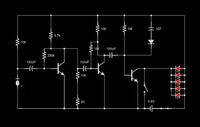Sizer009
Newbie level 3

Firstly Hi!...noob here....
Im trying to do a project with my two lads and don't know a great deal about electronics but I do know what we want to achieve
We want:
10 LED's to light up to music (all at the same time not a bar type thing).
To be able to turn it off and on.
To be able to turn off the light syncing leaving "all LED's" lit.
To be able to adjust the Electret Microphone Sensitivty.
To Run off USB.
At the moment I believe the power from the Microphone needs to be amplified but I dont know how or how much to amplify it by.
The Mic :
(0dB = 1V/µbar at 1kHz, Vcc = 4.5V, Rl = 1kΩ) 60dB ±3dB
**broken link removed**
Done a bit more digging around and found these circuits which I mocked up in iCurcuit....
Source for the left one : http://www.electro-tech-online.com/custompdfs/2012/11/picaxe_sound.pdf
Source for the right one (with video) : http://www.ledhoops.net/2011/10/01/sound-to-light-with-an-electret-microphone/
They both seem to work when simulated so was hoping for some input on wether they will actually work, which ones better or if there is a better solution.
Any help appreciated.


Im trying to do a project with my two lads and don't know a great deal about electronics but I do know what we want to achieve
We want:
10 LED's to light up to music (all at the same time not a bar type thing).
To be able to turn it off and on.
To be able to turn off the light syncing leaving "all LED's" lit.
To be able to adjust the Electret Microphone Sensitivty.
To Run off USB.
At the moment I believe the power from the Microphone needs to be amplified but I dont know how or how much to amplify it by.
The Mic :
(0dB = 1V/µbar at 1kHz, Vcc = 4.5V, Rl = 1kΩ) 60dB ±3dB
**broken link removed**
Done a bit more digging around and found these circuits which I mocked up in iCurcuit....
Source for the left one : http://www.electro-tech-online.com/custompdfs/2012/11/picaxe_sound.pdf
Source for the right one (with video) : http://www.ledhoops.net/2011/10/01/sound-to-light-with-an-electret-microphone/
They both seem to work when simulated so was hoping for some input on wether they will actually work, which ones better or if there is a better solution.
Any help appreciated.




